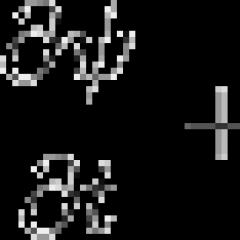House with a violin in China. Guggenheim Museum. Bilbao, Spain. Crooked House - Sopot, Poland
"Music Building" Hunan, China
Of great interest to tourists is an unusual “musical” building in China, the sight of which immediately leaves you guessing - what’s inside?
The Chinese city of Hunan has become much more famous with the opening of a new landmark - an original and beautiful building, the shape of which is very unusual. It is worth noting that this is not news for China. The construction of buildings with unusual shapes is the specialty of Chinese architects.
The Music Building was designed by architecture students from Hefei Institute of Technology and developed jointly with designers from Huainan Fangkai Decoration Project Co. This building consists of a huge piano and an equally huge cello attached to it. The shiny piano is black, and the cello body is made of transparent material, which provides a view of everything that happens inside the building. The cello building houses the main entrance and staircase. Thanks to the continuous glazing of the facades (clear and tinted glass), the premises of the complex receive the maximum possible amount of natural light. And at night, the body of the object disappears in the darkness, leaving only the neon contours of the silhouettes of giant “tools” visible. The main purpose of the construction of this building was to attract the attention of travelers. Well, besides this, in this building you can find information about the new district of the city.
Piano House was built for music lovers, but this building has nothing to do with music directly and is, in fact, an exhibition center. But this did not at all affect the attendance of the attraction by tourists who book air tickets and choose hotels to look at such an original structure and, of course, capture it in photos and videos.
Despite its popularity, the building is often the object of criticism as a kind of postmodern kitsch and a typical student project, in which there is much more outrageousness than art and functionality.
Guggenheim Museum. Bilbao, Spain
Until recently, the ancient city of Bilbao in the Spanish Basque Country could boast only medieval basilicas, churches, palaces and luxurious mansions of the nobility. But in 1997, on the banks of the Nervion River, which flows through the city, a building rose that attracted the attention of the entire enlightened world. The branch of the Guggenheim Museum houses within its walls not only a unique collection of modern art, but is itself a real work of art - this building is recognized as one of the most beautiful and spectacular in the world of all, built in the deconstructivist style.
The history of this branch of the now world-famous museum began in 1991, when representatives of the Basque Country turned to the Solomon Guggenheim Foundation, which has been supporting and developing contemporary art for several decades, with a request to help them in the cultural development of their region and the city of Bilbao in particular. The Basque proposal was heard, and the Foundation decided to build its next branch in Bilbao.
The American architect, winner of the most prestigious Pritzer Prize in the field of architecture, Frank Gehry, took on the task of developing the project for the future museum. By that time, Gehry had already established himself as a great master of deconstructivism on a large scale, boldly moving away from classical forms and experimented with architectural forms.
As a result of these experiments, a unique museum building appeared, which opened its doors to visitors in 1997. The structure, reminiscent in shape of either a giant flower or a futuristic interplanetary spacecraft, is spread over an area of 24,500 square meters. meters right on the banks of the Nervion River. The petals of this “flower,” 55 meters high, are made of glass and concrete, and each is, in fact, a suite of exhibition halls. The building's design is based on a steel frame consisting of three-meter lattice sections, the modeling of which was carried out on a computer, which made it possible to create previously impossible forms. Frank Gary uses soft curves in metal structures in all of his designs, explaining that “the randomness of the curves is designed to catch light.”
The museum is located below the level of the river and the entire city, this allowed the unusual structure, with all its grandeur and monumentality, not to suppress the surrounding buildings, not to hang over them, but to easily and gracefully fit into the city landscape.
The museum building is lined with titanium sheets reminiscent of fish scales, and glass surfaces, skillfully integrated into the structure, give the interior more light, making it almost transparent. This makes the museum look a little alien, but very impressive.
Opposite the Guggenheim Museum in Bilbao there are two interesting objects. The first is a huge metal spider made by the American Louise Bourgeois. The second interesting object near the building is a giant 13-meter puppy decorated with flowers, created again by American artist Jeff Koons.
The piano house or “musical” house, which is located in the city of Huainan in China. This unusual building, as a landmark of the Chinese city, made it possible to distinguish this city from many other cities.
The piano house or “musical” house, which is located in the city of Huainan in China. This unusual building, as a landmark of the Chinese city, made it possible to distinguish this city from many other cities. This building houses an exhibition complex, where the population is presented with a plan for the construction and development of a new area on which streets, houses and squares are displayed. Construction of the unusual house was completed in 2007. The reason for the construction of such an unusual house was the need to attract attention to development and the construction of a new area in the city. the main objective the construction of an unusual house in the shape of a piano and violin was to intrigue the public - in fact, this is what they achieved. The design of the piano house was carried out by students of Hefei University of Technology together with Huainan Fangkai Decoration Project Co.  The entrance to the building is through a huge violin, there is an escalator in it, which lifts people to the “grand piano”. The entire structure is made of black and transparent glass. In general, a lot of modern materials were used in the building, including glass. And the design of the unusual building included the opportunity to be amazed by its architecture, both during the day and at night. With a population of more than a million, Huainan is a fairly new attraction, an unusual building in the shape of a piano and violin, which has made their city famous throughout the world.
The entrance to the building is through a huge violin, there is an escalator in it, which lifts people to the “grand piano”. The entire structure is made of black and transparent glass. In general, a lot of modern materials were used in the building, including glass. And the design of the unusual building included the opportunity to be amazed by its architecture, both during the day and at night. With a population of more than a million, Huainan is a fairly new attraction, an unusual building in the shape of a piano and violin, which has made their city famous throughout the world. 
dPN-TPSMSH, iHBKOBOSH, lYFBK
nHJSCHLBMSHOBS BTIYFELFKHTTB CH VHLCHBMSHOPN UNSHUME UMChB
bTIYFELFKHTB - HCE UBNB RP UEVE FCHPTYUEUFChP, B RPRSHCHFLY UCHSBFSH EZP U DTHZYNY CHYDBNY YULHUUFCHB - LFP KhCE UTPDOY CHCHUYENH RYMPFBTCH. fBLYE RPRSHFLY DBCHOP HCE RTEDRTYOINBAFUS LBL CH PFOPEYOYY PFDEMSHOSHHI LMENEOFPC UPPTHTSEOYK, FBL Y CH PFOPEYOYY BDBOYK GEMYLPN. rTYNETPN YOFEZTBGYY BMENEOFPCH BTIIFELFHTSCH, RTYUEN YOFETBLFYCHOPZP IBTBLFETB, NPTsEF UMHTSYFSH MEUFOYGB-LMBCHYBFKHTB ABOUT PDOPC YUFBOGYK NEFTP CH UFPLZPMSHNE. x RBUUBTSYTPCH EUFSH CHSHCHVPT - CHIPDS H NEFTP, MYVP URKHULBSUSH RP ULBMBFPTH, MYVP OBTSYNBFSH OPZBNY ABOUT UFHREOY-LMBCHYY, LPFPTSCHE YZTBAF UPPFCHEFUFCHHAEHA OBTSBFPK LMBCHY OPPH.
OP, EUMY RTYDBFSH YOFETBLFYCHOSCHK IBTBLFET PFDEMSHOSCHN LMENEOFBN OE UPUFBCHMSEF FTHDB, FP UDEMBFSH LFP UP CHUEN ЪDBOYEN LTBKOE UMPTsOP. dB Y OE CHUEZDB CH LFPN EUFSH OEPVIPDYNPUFSH. rPTK UBNB BTIYFELFKHTB CHSHCHCHCHBEF FBLYE BNPGYY, YuFP OILBLYI DPRPMOYFEMSHOSHI DEKUFCHYK RTEDRTYOINBFSH, CH PVEEN-FP, Y OE FTEVHEFUS. yNEOOP FBL CHUE Y RTPYUIPDYF U DTHZYN PVTBJGPN “NHYSHCHLBMSHOPZP” UFTPYFEMSHUFCHB - dPNN-TPSMAN CH LIFBKULPN ZPTPDE iHBKOBOSH. dPN-TPSMSH - PFOADSH OE PVTBOPE UTBCHOOYE, B CHRPMOE PFTBTSBAEE CHOYOYK CHYD UPPTHTSEOYS OBCHBOYE.
yOUFTHNEOF, CH LPFPTPN KHNEEBEFUS UYNZHPOYUEULYK PTLEUFT
h BOZMYKULYI YUFPYUOILBI YOZHPTNBGYY LFP UPPTTHTSEOYE YUBEE OBSCHCHBAF “ADBOYE CH ZHTNE RYBOYOP Y ULTYRLY” YMY “tiano and V iolin S haped B wilding." fP CHRPMOE URTBCHEDMYCHP, FBL LBL CHUS BTIYFELFHTOBS LPNRPYGYS DEKUFCHYFEMSHOP CHLMAYUBEF DCHB NHYSHCHLBMSHOSHI YOUFTHNEOFB, LPFPTSCHE UB UUEF UCHPYI TBNETPCH IPTPY P ЪBNEFOSCH DBCE YЪDBMELB. CHEDSH BTIIFFELFHTOBS LPNRPYYY CHSHHRPMOEOB CH NBUYFBVE 1:50 Y RTEDUFBCHMSEF UPVPK RPYUFY LPRYY IPTPYP YJCHEUFOSCHI DBCE FEN, LFP OE SCHMSEFUS NEMPNBOPN, LMBUUYUEULYI NH ЪШЧЛБМШОСХИ ІУФТХНОПЧ - ТПССМ И ULTYRLY.
chShchVPT ZHPTN DMS TEBMYBGYY bFPZP BTIYFELFHTOPZP RTPPELFB VSHM RTPDYLFPCHBO DCHHNS RTYUYOBNY - UYNCHPMYUOPUFSHYOUFTHNEOPCH Y YI KHFYMYFBTOSCHNY ZHKHOLGYSNY. ZhPTNB TPSMS RPJCHPMSEF, LBL OEMSHЪS MHYUYE TBURTEDEMYFSH RTPUFTBOUFChP DMS CHSHCHUFBCHPYUOPZP LPNRMELUB, B ZHTNB CHETFYLBMSHOP TBURMPPTSEOOOPK ULTYRLY DBEF CHPNPTsOPUFSH TBNEUF YFSH CH OEK MEUFOYGH, RP LPFPTPK RPUEFYFEMY RPDOINBAFUS CH BMSC. fBLYN PVTBBPN, dPN-TPSMSH PDOPCHTENEOOOP PFCHEYUBEF Y UFEFYUEULYN Y RTBLFYUEULYN FTEVPCHBOYSN. th FP Y DTHZPE DMS OEZP CHBTsOP, RPULPMSHLH dPN-TPSMSH CHSHRPMOSEF EEE PDOKH - TELMBNOKHA ZHKHOLGYA.
FChPTYUEUFChP - LBL UYNCHPM RPLPTEOYS OPCHSCHI THVETSEK
uFTPYFEMSHUFCHP dPNB-TPSMS VSHMP UBCHETYEOP CH 2007 ZPDH. h LFP CHTENS ZPTPD iHBKOBOSH, TBURPMPTSEOOSCHK h LYFBKULPK RTPCHYOGYY BOSHIPC, YURSHCHFSHCHBM OEPVIPDYNPUFSH H RTYCHMEYUEOYY CHAINBOYS L TBCHYFYA OCHPZP TBKPOB. VSHMP RTYOSFP TEYEOYE UDEMBFSH dPN-TPSMSH UINCHPMPN EEE PDOPK, VHDHEEK YUBUFY ZPTPDB, RBTBMMEMSHOP RTYDBCH ENKH ZHKHOLGYY CHSHCHUFBCHPUOPZP LPNRMELUB, ZDE, CH FPN YUYUME, VHDHF RTEDUF BCHMEOSCH RHVMYLE Y RMBOSH UFTPYFEMSHUFCHB OPCHPZP TBKPOB CHNEUFE U KHMYGBNY, DPNBNY Y RMPEBDSNY. OBTSDKH U TELMBNPK OPCHPUFTPEL, CH RMBOE TBVPFSH dPNB-TPSMS OE YULMAYUBMYUSH Y LURPYGYY ABOUT DTHZYE FENCH.
fBL, VMBZPDBTS UCHPEK PTYZYOBMSHOPK BTIYFELFHTE dPN-TPSMSH ChPYYEM CH OEPZHYYBMSHOSCHK URYUPL KHDYCHYFEMSHOSHI SCHMEOYK NYTPCHPK BTIYFELFHTSCH ULPTEE, LBL OEPVSHYUOPE ЪDBOYE, YUEN LB L DEKUFCHYFEMSHOSCHK YEDECHT ЪPDYUEFCHB. UBN RP UEVE dPN-TPSMSH - DEKUFCHYFEMSHOP LLUFTBPTDYOBTOPE FCHPTEOYE. pDOBLP CH NYTE DPUFBFPYUOP NOPP RPRSHFPL TEBMYIPCHBFSH CH DYBKOYE BDBOYK UIPDUFCHP U LBLYNY-MYVP RTEDNEFBNYY DBTSYCHSHCHNYY UKHEEUFCHBNY. dBCE EUMY dPN-TPSMSH Y OE CHYYEM CH URYUPL NYTPCHPZP BTIYFELFKHTOPZP OBUMEDYS, UCHPEK ZMBCHOPK GEMY - ЪBYOFTYZPCHBFSH PVEEUFCHEOOPUFSH - PO, OEUPNOOOOP, DPVIMUS.
"fYRYYUOSCHK UFHDEOOYUEULYK RTPELF", RTPZTENECHYK ABOUT CHUSH NYT
UFPYF PFNEFYFSH, YUFP CH PVUKHTSDEOSI LYFBKULPZP dPNB-TPSMS CHUFTEYUBEFUS PUEOSH NOPZP LTYFYLY CH BDTEU DYBBKOB JDBOYS. lFP-FP PFNEYUBEF CH OEN RTYOBLY "OBDPECHYEZP RPUFNPDETOYNB", B LFP-FP OBSCHCHBEF EZP "FYRYUOSCHN UFHDEOOYUEULYN RTPELFPN". pDOBLP VPMSHYOUFChP OE NPTSEF OE RTYOBFSH PTYZIOBMSHOPUFY ЪBNSHUMB, LPFPTSCHK RTY CHPNPTSOSHI OEDPUFBFLBI, DEKUFCHYFEMSHOP RTPYCHPDYF CHREYUBFMEOYE. oKH B FP, YuFP CH BTIYFELFHTE dPNB-TPSMS VPMSHYE RBFBTSB, YUEN YULHUUFCHB, NPTsOP MEZLP PVASUOYFSH UFPMSH UCHPKUFCHEOOSCHNY NPMPDSHCHN BTIYFELFPTBN BNVYGYSNY.
CHEDSH RPTPELFYTPCHBOYEN dPNB-TPSMS ЪBOYNBMYUSH UFKhDEOFSH PFDEMEOOYS BTIYFELFHTOPZP DYBBKOB IEZHEKULPZP FEIOPMPZYUEULPZP HOYCHETUYFEFB UPCHNEUFOP U DYBKOETBNY LPNRBOY "H uainan F angkai D ecoration P roject Co." h RTPELFE ЪДBOYS VSHMP YURPMSHЪPCHBOP NOPZP UPCHTENEOOSCHI NBFETYBMPCH, CHLMAYUBS UFELMP. b CH EZP DYBKOE VSHMB RTEDKHUNPFTEOB CHPNPTsOPUFSH KhDYCHMSFSHUS OEFTYCHYBMSHOPK BTIYFELFKHTE, LBL RTY DOECHOPN UCHEFE, FBL Y CH OPYUOPE CHTENS. fBL YuFP VPMEE YUEN NYMMMYPOOPE OBUEMEOYE iHBKOBOS CHRPMOYE DPCHPMSHOP OPChPK DPUFPRTYNEYUBFEMSHOPUFSHA, LPFPTBS FERETSH EEE Y RTUMBCHYMB YI ZPTPD ABOUT CHUSH NYT.
What are the strangest buildings in the world? Today we will talk about which buildings are the strangest in the world.
Looking at them, you are amazed how a person could create this. They really are the weirdest.
Crooked House - Sopot, Poland
IN city of Sopot on the street of Heroes of Monte Cassino ( Poland) one of the most unusual houses on the planet is located, it is called - crooked house(in Polish - Krzywy Domek). Looking at it, you get the impression that it either melted in the sun and became distorted, or it is an optical illusion and it is not the house itself, but a reflection in a huge, crooked mirror.
Stone House – Portugal

The Casa do Penedo house in the mountains of Portugal, built between four boulders, resembles a Stone Age dwelling. The isolated hut was built in 1974 by Vitor Rodriguez and was intended for relaxation away from the hustle and bustle of the city.
The desire for simplicity did not make the Rodriguez family hermits, but brought them closer to a natural lifestyle without excesses. Electricity was never installed in the house; Candles are still used for lighting here.
And the room was heated using a fireplace carved into one of the boulders. The stone walls serve as a continuation of the interior decoration: even the steps leading to the second floor are carved directly into the stones.
Piano House - Huainan, China

Who better than China can surprise with its invention. The glass set consists of two musical instruments: a grand piano and a violin (looking at the size of the instruments, one might assume for a moment that some giant left them here).
There are a great many interesting, unique buildings all over the world, but not the building of a piano with a violin.
This amazing house called Piano House was built in Huainan (Anhui Province, China) according to the project of students of the Faculty of Architecture of Hefey University of Technology, developed jointly with the company's designers Huainan Fangkai Decoration Project Co.
Piano House consists of two parts depicting two instruments - a transparent violin resting on a translucent piano.
The unique building was built for music lovers, but has nothing to do with music. In the violin there is an escalator, and in the piano there is an exhibition complex in which plans of streets and districts of the city are presented to the attention of visitors.

The facility was created at the suggestion of local authorities. The unusual building seeks to attract the attention of Chinese residents and numerous tourists to the new developing area, in which it is the most iconic object. Thanks to the continuous glazing of the facades (clear and tinted glass), the premises of the complex receive the maximum possible amount of natural light. And at night, the body of the object disappears in the darkness, leaving only the neon contours of the silhouettes of giant “tools” visible.

Despite its popularity, the building is often the object of criticism as a kind of postmodern kitsch and a typical student project, in which there is much more outrageousness than art and functionality.



